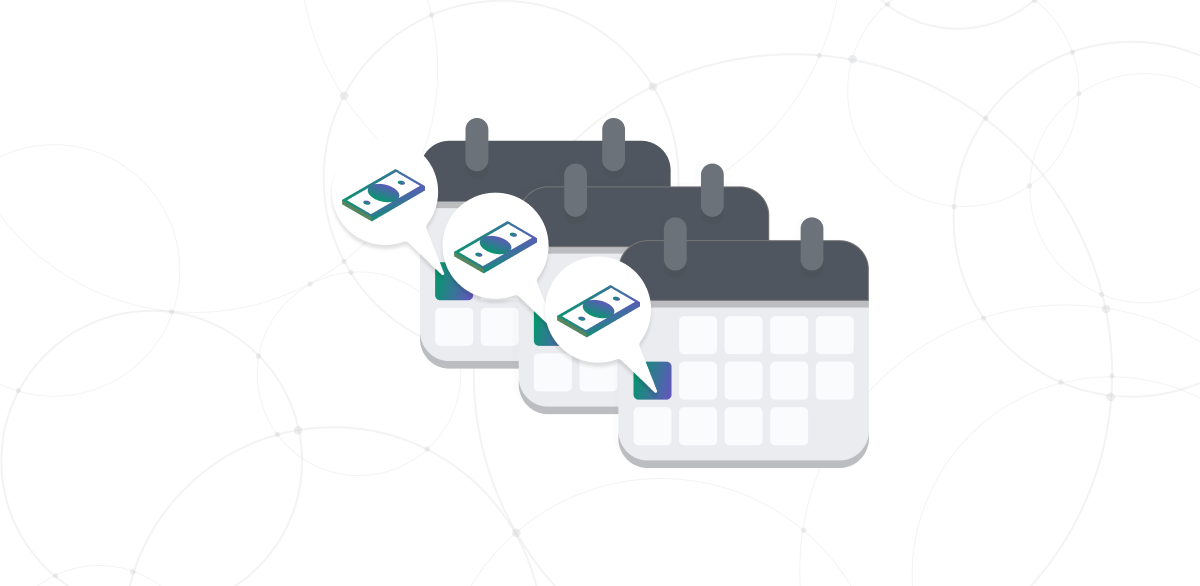Introduction
The emergence of Variable Recurring Payments (VRPs) has revolutionized the payments industry, captivating the interest of consumers, merchants, and financial institutions.This article dives into the world of VRPs, analyzing their impact, advantages, and implications for both businesses and customers.

Understanding Recurring Payments
Let’s start with some brief introductions on some of the VRP terminology, before jumping into the topic more deeply.
Definition and Concept: Recurring payments involve automatic deductions of predetermined amounts at regular intervals, providing a convenient and automated method for various ongoing services and subscriptions. Recurring payments provide stability and predictability for both consumers and businesses, streamlining the payment process and promoting convenience in managing financial obligations.
Fixed vs. Variable Payments: While fixed recurring payments remain constant, variable recurring payments adapt based on usage or consumption, such as utility bills.
Variable Recurring Payments: VRPs, stemming from the European Union’s PSD2, enable secure connections between authorized payment providers and bank accounts. This connection enables the providers to make ongoing payments on behalf of the customers, introducing flexibility, transparency, and security.
How VRPs Compare to Traditional Recurring Payments:
VRPs offer more control and convenience compared to traditional methods like direct debit and continuous payment authority (CPA), allowing customers to modify transactions directly from their banking apps and eliminating unnecessary authentication steps.
VRPs grant customers the ability to manage parameters such as payment frequency, maximum amount, and permission end date, as well as the flexibility to cancel payments or revoke third-party provider access whenever they choose.
By integrating the benefits of direct debit and open banking payments, VRPs provide improved security, immediate processing, and irreversible transactions.

How VRPs are Transforming the Payments Industry
To streamline financial management, the UK’s Competition and Markets Authority (CMA) has directed the CMA9, nine major banks, to adopt a VRP open banking API. This step aims to simplify fund sweeping, allowing customers to transfer funds from their current accounts to other accounts seamlessly.
With the potential for further advancements, VRPs are on the brink of revolutionizing variable recurring payments, reshaping how consumers handle bill payments and how merchants ensure secure transactions.
The Benefits of Sweeping:
VRPs introduce a groundbreaking money management solution known as sweeping, revolutionizing how funds are handled through automated transfers between linked bank accounts.
With sweeping, customers can effortlessly allocate funds from their current account to savings or loan accounts, effectively maximizing their financial assets.
However, sweeping goes beyond mere transfers. By leveraging VRPs, third-party payment providers can establish specific parameters to enhance money management. 
With sweeping, customers have the flexibility to set maximum spending limits within their current accounts, ensuring that any surplus funds are automatically redirected to accounts offering higher interest rates or investment portfolios. This automated process empowers individuals to optimize their financial objectives and maximize their returns.
Additionally, sweeping acts as a preemptive safeguard against overdrafts, employing triggers that allow funds to “parachute” from other accounts. This mechanism ensures a positive balance in the current account, protecting individuals from potential financial setbacks.
Through the utilization of VRPs and the sweeping process, individuals can streamline their financial transactions, minimize manual interventions, and exert enhanced control over their financial stability. The convenience and automation provided by sweeping through VRPs make it an indispensable tool for effective personal finance management in today’s modern world.

VRPs Use Cases
At present, VRPs have exclusively been introduced in the UK, which typically remains 12-18 months ahead of the EU. However, as the rest of Europe catches up and adopts this technology, the gap is gradually narrowing. Nonetheless, the UK stands as the current frontrunner in open banking innovation.
Opportunities for Non-Sweeping Variable Recurring Payments
Although the CMA9 banks are not obligated to offer non-sweeping VRPs, substantial prospects for businesses and consumers to benefit from these payment services exist. Non-sweeping VRPs can facilitate various advantages, including:
- Managing Regular Bills: Non-sweeping VRPs streamline the process of handling regular bills, such as utility payments. By automating these payments, businesses and consumers can ensure prompt and hassle-free settlements.
- Subscription Service Management: Non-sweeping VRPs present a convenient solution for managing subscription services. Customers can effortlessly set up recurring payments for streaming platforms or membership subscriptions, guaranteeing uninterrupted access while providing businesses with a dependable payment method.
- Simplifying Tax Payments: Non-sweeping VRPs assist businesses in efficiently managing their tax obligations. By earmarking funds for taxes and VAT at the invoice collection stage, these payment services simplify the process, enabling businesses to meet their tax responsibilities accurately and punctually.
- Indemnity Claim Reduction: Businesses often encounter complications with Direct Debit indemnity claims. Non-sweeping VRPs offer an alternative approach that eliminates the intricacies associated with indemnity claims. By leveraging these payment services, businesses can mitigate risks and streamline their payment processes.
Although not mandatory, non-sweeping VRPs present promising opportunities for businesses and consumers to enhance financial management, streamline payments, and improve overall efficiency across various aspects of their financial transactions.
Advantages of VRPs for Merchants
- Fraud Protection and Payment Success: VRPs with strong customer authentication minimize fraud risks and failed payments, ensuring secure transactions.
- Cost Savings: Open banking payments used in VRPs bypass expensive card schemes, reducing payment processing costs and improving profitability.
- Efficient and Irrevocable Payments: VRPs offer seamless and irrevocable account-to-account transactions, eliminating disputes and streamlining payment experiences.

Advantages of VRPs for Consumers
- Enhanced Security: VRPs employ secure open banking technology, protecting consumers’ financial information without requiring sensitive card or account details.
- Optimized User Experience: VRPs provide a fast and user-friendly payment experience, granting consumers control over recurring payments and eliminating manual processes.
- Effective Financial Management: Through sweeping, consumers can easily save money and avoid overdraft fees, while VRPs automate savings and promote sound financial practices, reducing late payments and collection time.
Businesses that can Benefit From Using Variable Recurring Payments
The businesses that will gain the most from using VRPs are Subscription-Based Services, including:
- Streaming platforms
- Software-as-a-Service (SaaS) providers
- Membership-based organizations
- E-commerce Businesses:
- Subscription boxes
- Installment payment options
- Professional Service Providers:
- Consultants
- Fitness studios
- Maintenance services
By implementing recurring payments, these businesses can streamline revenue collection, improve cash flow predictability, reduce administrative burdens, and enhance customer convenience and satisfaction.
Challenges & Disadvantages of Variable Recurring Payments
The introduction of variable recurring payments brings with it a set of challenges that need to be carefully considered. While this innovative technology holds promise, its widespread acceptance by the market remains uncertain.
One of the critical concerns surrounding variable recurring payments is the issue of customer trust. This payment method requires customers to share their bank information with a third party, such as a fintech company.
Trust is crucial in the financial sector, and customers must have confidence that their sensitive financial data will be handled securely. The willingness of customers to share their bank information can only be determined over time, as fintech companies gain experience in implementing and safeguarding this technology.
Financial institutions would potentially need to adapt their existing IT infrastructure to accommodate this new payment method, which can be a complex and resource-intensive process.
Additionally, the availability of competitive technologies that offer immediate improvements poses a challenge to the adoption of variable recurring payments. Financial institutions and consumers alike may be hesitant to invest in a new payment system if there are alternative solutions that already meet their needs effectively.
Only through time and experience will the true viability and acceptance of variable recurring payments be determined in the market.
What Lies Ahead for VRPs?
The realm of VRPs is just beginning, and their future applications extend well beyond sweeping. VRPs have the potential to facilitate transfers between accounts belonging to different individuals or businesses, catering to various use cases including e-commerce and more.
In the coming years, VRPs could coexist with or even replace other forms of recurring payments. They hold the promise of streamlining payment processes for a wide range of common recurring expenses, such as:
- Household bills (electricity, gas, etc.)
- Insurance policies
- Streaming services like Spotify or Netflix
- Transportation-hailing apps like Uber or Lyft
- Investment services
As VRPs continue to evolve, we can expect to witness their integration into diverse sectors, bringing enhanced convenience and efficiency to everyday financial transactions.

Final Word
Financial institutions have a significant opportunity to empower their customers by embracing Variable Recurring Payments (VRPs). By recognizing the potential of VRPs, banks can go beyond their traditional role as custodians of funds and become essential partners in their customers’ financial journeys.
As the payments landscape evolves, VRPs have the power to reshape the industry, placing a renewed focus on customers and their digital wallets. To remain competitive, financial institutions must strategize and innovate, ensuring they stay at the forefront of their customers’ minds. It is crucial for firms to explore how they can effectively implement VRPs and capitalize on the opportunities they offer.
For further insights and guidance on VRPs, financial institutions can seek support from industry experts who can assist in navigating the implementation process and leveraging the potential of VRPs.
Variable Recurring Payments have introduced a new era in recurring transactions, benefiting both businesses and consumers. With their enhanced control, convenience, and security, VRPs are set to revolutionize the payments industry and shape the future of financial transactions.
- SEO Powered Content & PR Distribution. Get Amplified Today.
- PlatoData.Network Vertical Generative Ai. Empower Yourself. Access Here.
- PlatoAiStream. Web3 Intelligence. Knowledge Amplified. Access Here.
- PlatoESG. Automotive / EVs, Carbon, CleanTech, Energy, Environment, Solar, Waste Management. Access Here.
- BlockOffsets. Modernizing Environmental Offset Ownership. Access Here.
- Source: https://www.finextra.com/blogposting/24527/exploring-variable-recurring-payments-vrps-features-and-advantages?utm_medium=rssfinextra&utm_source=finextrablogs



